MY ANALYSIS

After all, that is the way all human knowledge has advanced since the beginning of time, by intuition, either by a sudden insight interrupting our conscious minds or by an even more startling insight that arrives via psychic event, such as a vision. We can see this even in modern times. Einstein himself was a champion of intuition: " The intuitive mind is a sacred gift and the rational mind is a faithful servant. We have created a society that honors the servant and has forgotten the gift."
Another well-documented case of intuition concerns Frederick Kekule's (1829 - 1896) discovery of the structure of benzene. Kekule saw the answer in a dream of a snake coiled and biting its  tail. In an intuitive flash, he realized that the molecular structure was characterized by a ring of carbon atoms. Benzene is a 6 carbon ringed compound with 6 hydrogen atoms with the carbon-carbon bonds arranged alternately single and double. This discovery opened the way to modern theories of organic chemistry.
tail. In an intuitive flash, he realized that the molecular structure was characterized by a ring of carbon atoms. Benzene is a 6 carbon ringed compound with 6 hydrogen atoms with the carbon-carbon bonds arranged alternately single and double. This discovery opened the way to modern theories of organic chemistry.
My own experiences with intuition makes me favor the interpretation of these preliterate "aliens creating/teaching human" glyphs as metaphoric representations of the arrival of an insight. After all, that is the way the preliterate mind operated: it expressed (and interpreted) events in terms of art ( oral story poems, drawings, carvings, etc.) which are metaphoric by their nature.
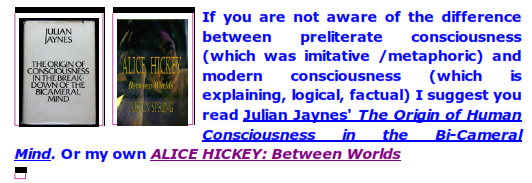
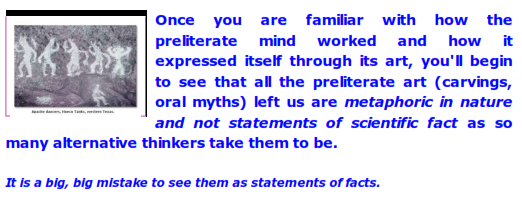

I see most of these alternative views as being no more than highly speculative, imaginative exercises made possible by the fact that prehistoric cultures (having no writing) left no evidence as to how and why their great monuments were constructed, as well as no written evidence as to the nature of their cultures and how they evolved.

Every bit of rigorous scientific evidence suggests that the people of Stonehenge had the same intelligence and mental capabilities as the Parthenon Greeks. Therefore, if the Greeks could figure out how to build the Parthenon, the early Britons could figure out how to build Stonehenge. Period. End of Argument.
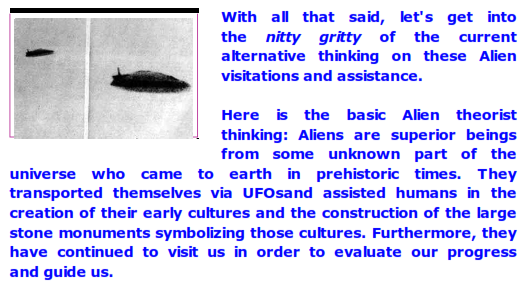


Alien theorists see these misinterpretations being the result of conventional science failing to see that the many
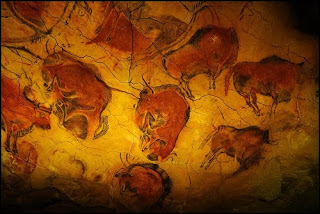
recorded appearances of various Gods in preliterate and early literate times were, in reality, recordings of physical visits by advanced beings from some other (or alternative) part of the universe.

Assumption 3: Alien theorists hold that there is no other universe (e.g., a spiritual or psychic universe) than the physical universe, a view it holds in common with our modern scientific view of the universe.
Let's analyze each of these assumptions:
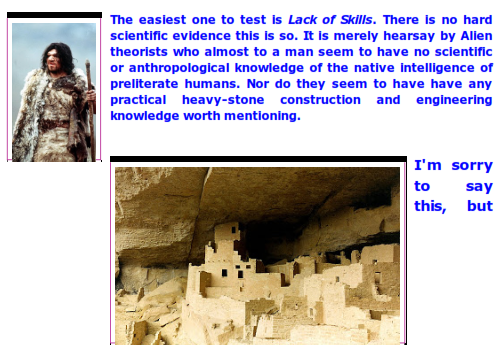
most Alien theorists are basically well-meaning theorists who have fabricated a rather sloppy position which holds that humans living in preliterate and early literate cultures lacked the intelligence, organization and problem-solving ability necessary to design and construct large stone structures.
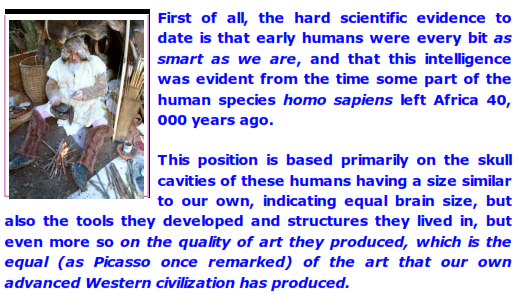

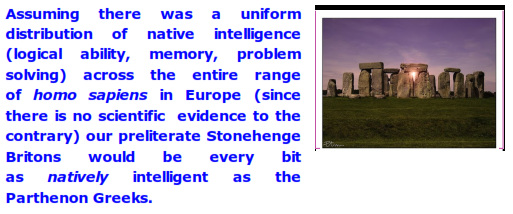
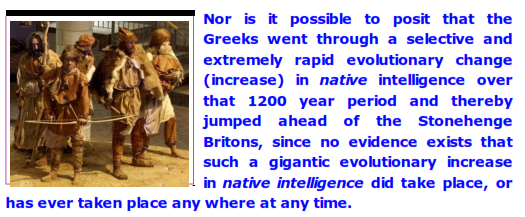
What did happen to the Greeks, however, was that they learned how to read and write before constructing the Parthenon and and the Britons didn't before constructing Stonehenge.
What writing changed for the Greeks was not native intelligence, but how they looked at themselves and the world, i.e., the Greeks experienced a true, very rapid evolutionary change in the nature of their consciousness, not their intelligence. I'll say more about this later.
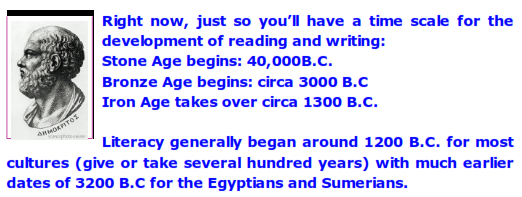
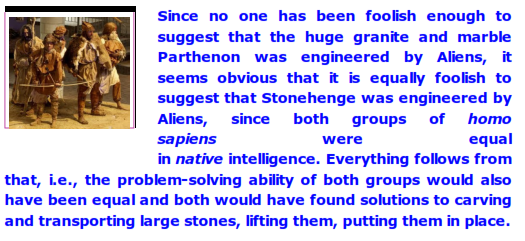
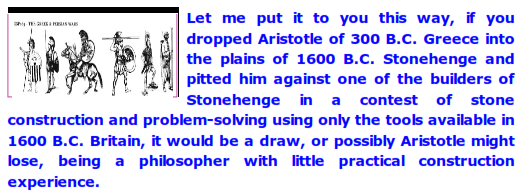

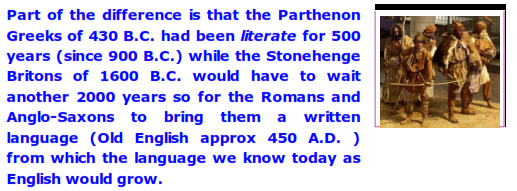

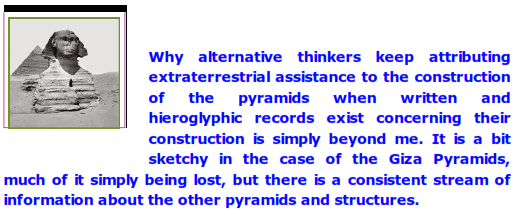
However, since there were no written records in preliterate cultures, such as Stone Age Britain, alternative thinkers are free to make it up in any way they please for edifices such as Stonehenge.
But a written language per se, is not really the point. The point is that concurrent with the advent of writing, there came the ability to accurately record thoughts and events of all kinds, and out of that grew not only a huge amount of reference material, but more importantly, a very rapid evolutionary change in consciousness ( not native intelligence ) that was capable of examining and reporting on everything, which in turn gave birth to Greek mathematics, history, science, medicine etc.
Out of that, of course, eventually came a sense of art and architecture that could be passed down in great detail to future generations and in turn modified generation after generation, so that by 430 B.C, an extremely detailed tradition would exist, such as we see evidenced in the design of the Parthenon that was far more sophisticated than the rough stone structures of preliterate Greece, one of which is shown below, and which is not much different from Stonehenge.
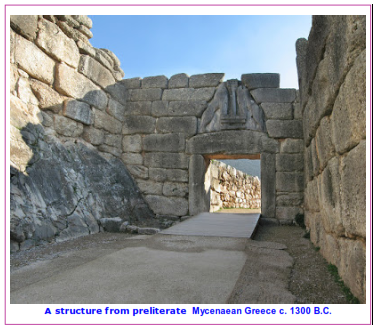
The native intelligence of the Greeks didn’t increase or change between Mycenean Greece and the Greece of the Parthenon. What changed was the way the Greeks looked at the world because of literacy, i.e., they began to examine the world logically and record everything around them. This logical, examining way of knowing the Greeks termed logos knowing. Needless to say, the knowledge that came with literacy grew slowly at first then like a chain reaction until it was encyclopedic by 430 B.C. (500 years after the advent of Greek literacy.)
A good metaphor would be that writing allowed the Greeks to develop a history of architecture and different ways of construction. The preliterate Stonehenge Britons however, had no way of doing this, of accumulating factual knowledge in great detail. They only had their oral story poems and carvings, which are very poor vehicles for recording facts, but excellent vehicles for imitating and expressing the mysteries of life and death.
The Greeks called this preliterate way of knowing Muthos. For our Stonehenge Britons, Muthos immersed them in their all-consuming, spiritual preliterate culture, which was of the greatest importance to them: it was what interested them as a culture.
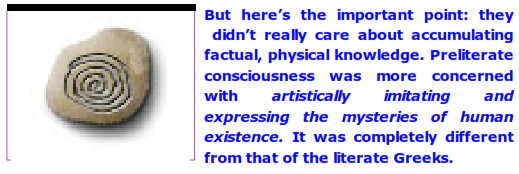
(As an aside, let me say that it is the height of idiocy to theorize that the ancient artistic/ spiritual Britons arranged stones and the like to guide advanced UFO craft in navigating around the globe. After all, if the craft could come across hundreds of light years to visit us, I think they could find their way around the planet once they got here, don't you?)
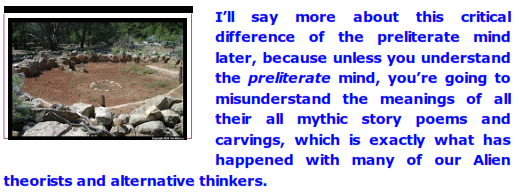
Yet we shouldn’t let this supposed preliterate disinterest in explaining things convince us for one moment that these preliterate humans weren’t as natively intelligent as we are. Rather, their intelligence was intensely focused on spiritual matters and the artistic imitations of those concepts.
We’ll see shortly that their artistic achievements were so accomplished as to leave no doubt as to their native intelligence being equal to that of the a Parthenon Greeks.
 But to get back to the point at hand: Greek literacy resulted in a highly developed Greek sense of architecture, which is a partial way of explaining the architectural differences between the Parthenon and Stonehenge. But the other thing that made the real difference between the Parthenon and Stonehenge were the tools each culture had to work with.
But to get back to the point at hand: Greek literacy resulted in a highly developed Greek sense of architecture, which is a partial way of explaining the architectural differences between the Parthenon and Stonehenge. But the other thing that made the real difference between the Parthenon and Stonehenge were the tools each culture had to work with.
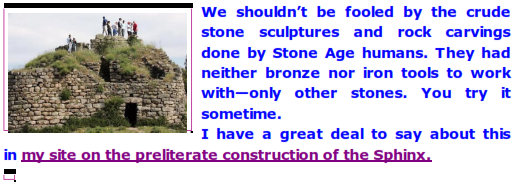
Although some gold and silver jewelry has survived from the Stone ages, all the other art forms (wood drawings and carvings, fabric drawings, etc) have perished, and these were undoubtedly the dominant materials used for art.
The only art form, outside of jewelry, that has survived en masse over the millennia are stone structures and rock carvings. They are everywhere, but their function remains uncertain in many cases. See megaliths
Finally let me say this because it’s the elephant in the room: the Stonehenge Britons probably didn’t care about “finishing” their stones as the Parthenon Greeks did. Part of that is due to the fact that the hard granite of the huge sarsens is very difficult to shape with stones. Yet as the Egyptians showed with their obelisks, which were hard granite, it could be done with very hard stones called dolomite.
The real reason why the Stonehenge Britons didn't care is due to the fact that what was really important to the preliterate Stonehenge Britons were the spiritual implications of these stones, as stones, which all preliterate cultures saw as imperishable, like the Gods. It should be obvious to anyone by this time that outside of the stone burial structures built by many of these cultures, stones—as stones— were also used in a spiritual, even a healing way, by prehistoric cultures. Their timelessness was Godlike, so it is no wonder they were seen as having healing powers.
There is increasing archeological evidence that the smaller, more numerous blue stones inside the larger sarsens at Stonehenge were used as part of a healing process. Why we don’t know, but it seems now that they were.
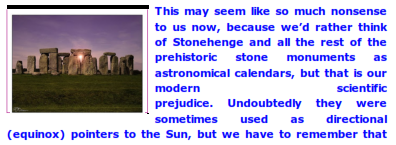
those planting and harvesting directions were also highly spiritual. God = Sun, remember?
As for dolmens, the long rows and arrangements of stones, it’s obvious they had a spiritual, perhaps a healing purpose. We don’t really know why they saw stones in such a way, or why they arranged them in the way they did, or exactly how they were used, but it’s obvious these stones had to have served a special purpose. It was very hard work moving and lifting them, right? It wasn’t a whim.
For prehistoric cultures, everything was spiritual. It’s the key to understanding them and their art, which was driven by visions, not conscious planning.
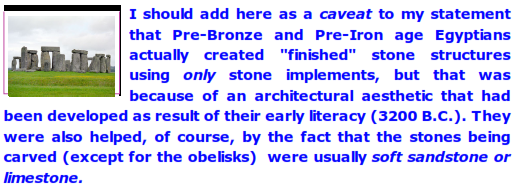
But what is important in my comparison of the Stonehenge Britons and the Parthenon Greeks is that both cultures (Greeks, Britons) had the same native intelligence when it came to solving the intricacies of quarrying, transporting, carving, lifting and moving very large stones.



You don’t need beam-lifting spaceships (L) for Stonehenge
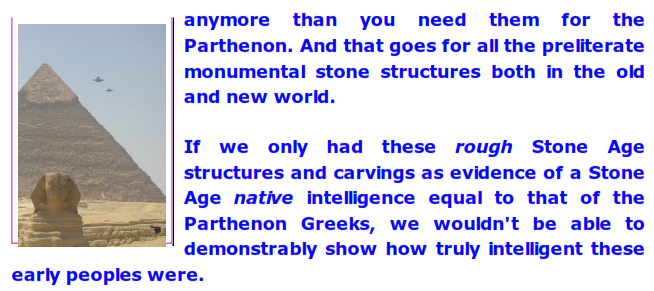
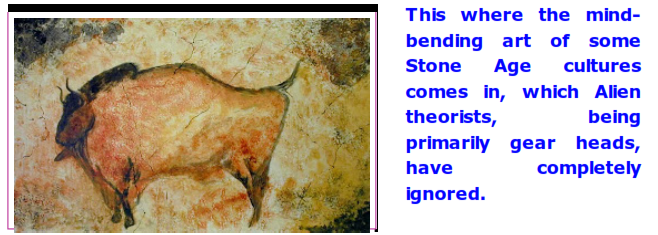
There isn't any doubt in anybody's mind today that high aesthetic capability is a certain indicator of high native intelligence. Fortunately, despite the ravages of time, certain non-stone art forms have been miraculously preserved (such as the cave drawings in Altamira and other European caves which date to some 18,000 to 35,000 years ago—Stone Age Europe.)
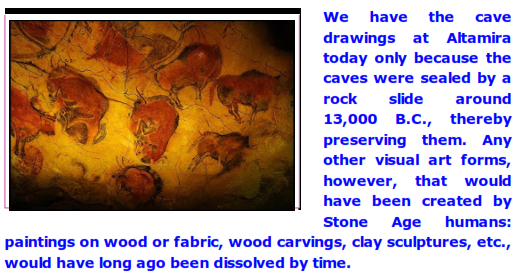
However, a few very early fired-clay sculptures have miraculously survived, such as the Venus of Willendorf, an 11 cm (4.3 in) female figure estimated to have been made between 24,000 and 22,000 B.C.. If you don’t think this statue is as sophisticated and mysterious as anything made by Brancusi or Picasso, you should wake up, or at the very
If you don’t think this statue is as sophisticated and mysterious as anything made by Brancusi or Picasso, you should wake up, or at the very least, read the squabbling interpretations of anthropologists and archeologists to show you how mysterious this figure really is because they don’t have a clue.
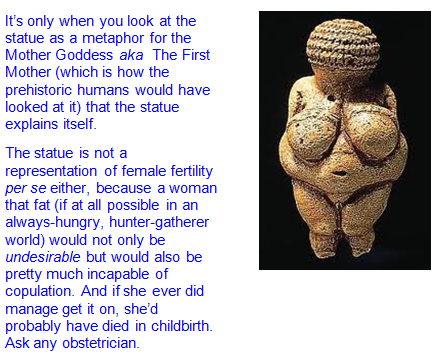
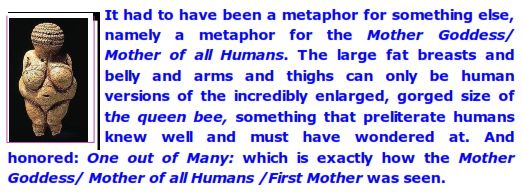
The fact that you can’t see her face is also spiritual. Ask the ancient Hebrews about that. For early Hebrews, God's name couldn't be spoken, meaning God is beyond comprehension, which is another way of saying: God's face shouldn’t/couldn’t be seen because it was beyond comprehension and would cause death. Look away, Moses! Remember how Moses was warned about not trying to look at God’s face? The same thing is being represented by this faceless Mother Goddess.
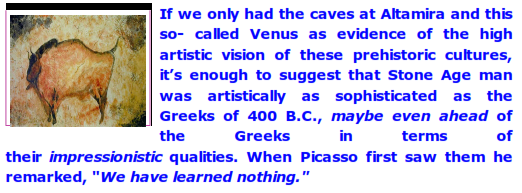
It’s far more modern than what the Greeks were doing, as beautiful as that was. Think about it.
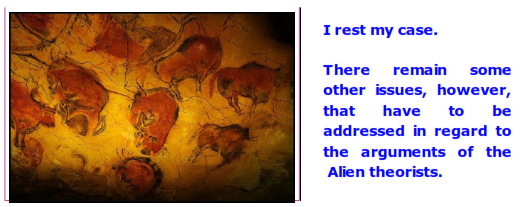
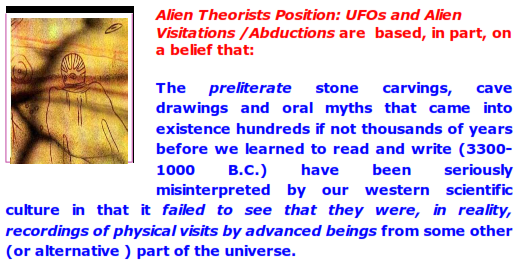
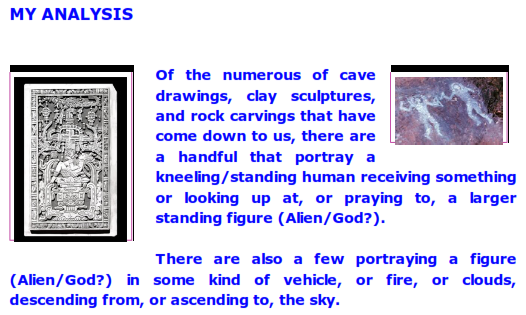

The great oral myths (Book of Moses, Odyssey, Iliad, Gilgamesh) that eventually were transcribed into writing also contain verbal descriptions of similar events (God giving Ten Commandments to Moses, Athena advising Odysseus).


After all, these were cultures whose inhabitants were constantly experiencing voices and visions. The correct way to look at these great stories ( Genesis, Gilgamesh, Iliad) is to see them as waking dreams that reflected the truths and beliefs that held these cultures together.
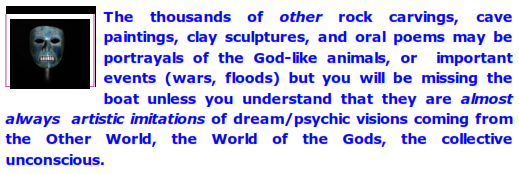
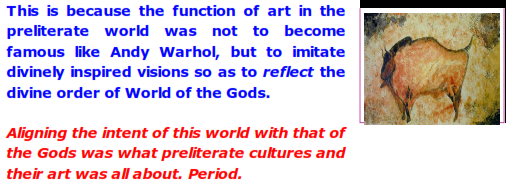
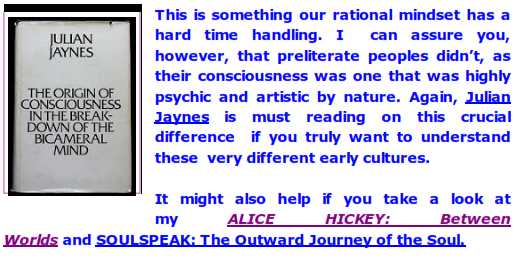





 tail. In an intuitive flash, he realized that the molecular structure was characterized by a ring of carbon atoms. Benzene is a 6 carbon ringed compound with 6 hydrogen atoms with the carbon-carbon bonds arranged alternately single and double. This discovery opened the way to modern theories of organic chemistry.
tail. In an intuitive flash, he realized that the molecular structure was characterized by a ring of carbon atoms. Benzene is a 6 carbon ringed compound with 6 hydrogen atoms with the carbon-carbon bonds arranged alternately single and double. This discovery opened the way to modern theories of organic chemistry.











































